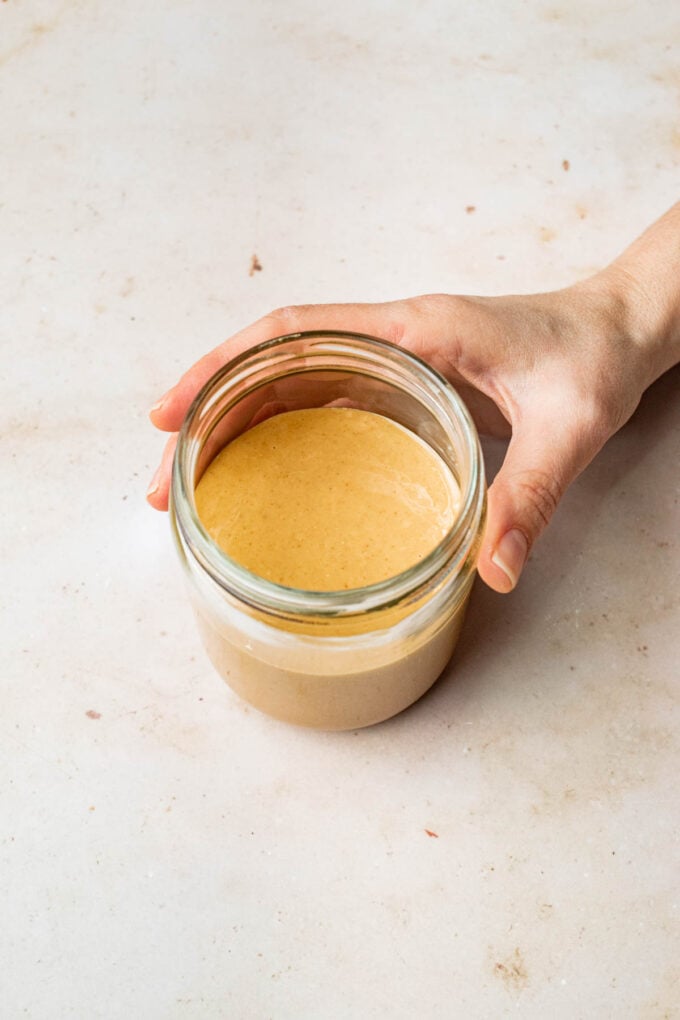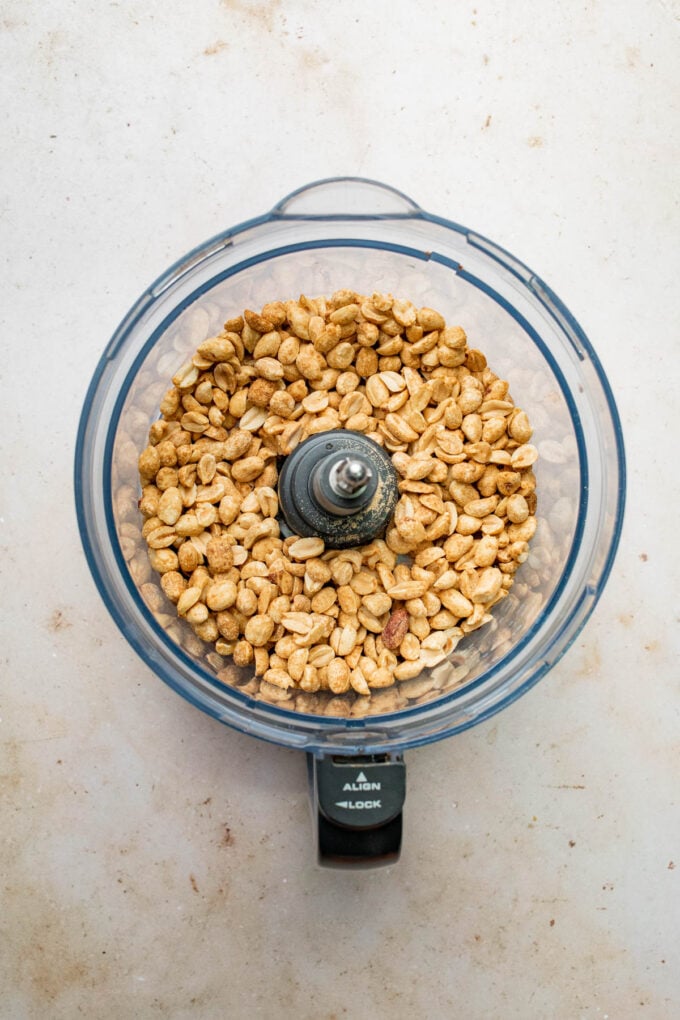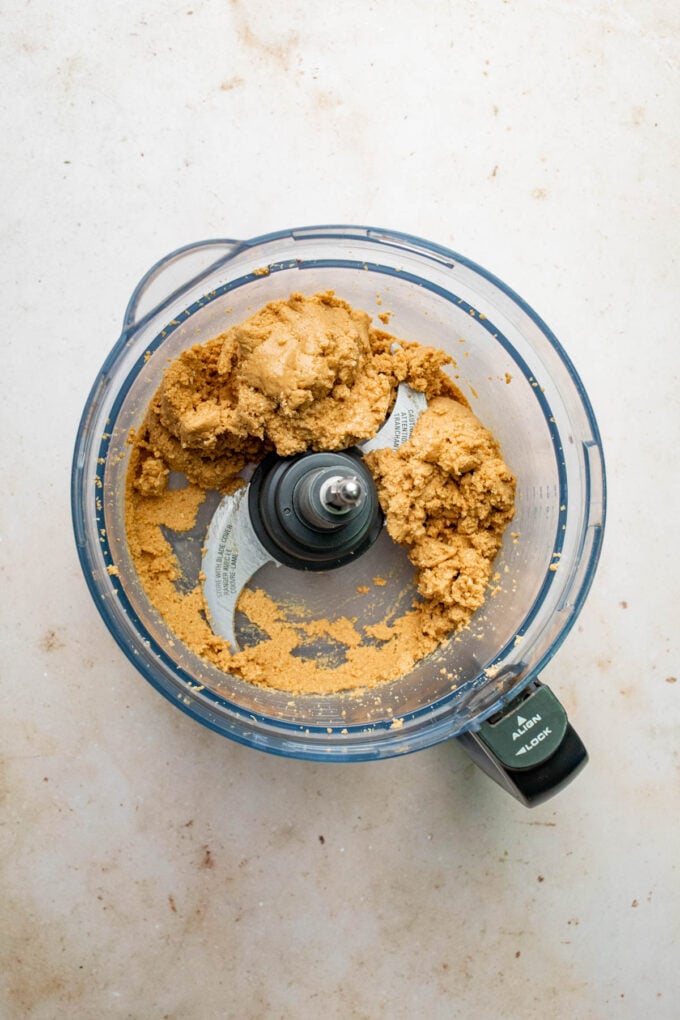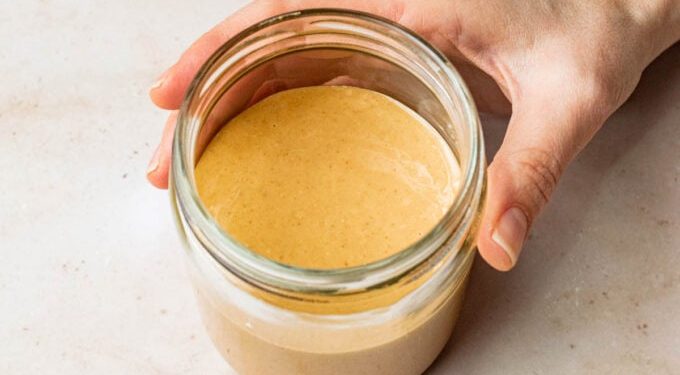Prepare to be shocked at how easy it is to make delicious homemade peanut butter. One ingredient. Five minutes. And a creamy, nutrient-dense peanut butter to slather all over toast or use in your favourite recipes. Never run out of peanut butter again!

If I’m honest with myself, peanut butter is probably one of my ride-or-die foods. Everything is made better with peanut butter. I mean, who doesn’t want a chocolate peanut butter smoothie? Or a peanut butter cookie? Or noodles glazed in peanut sauce?
Before I went to school to become a dietitian, I worked my way across Asia – I’m talking from Japan to Indonesia and (almost) everywhere in between! What was in my suitcase? Peanut butter. The natural kind. No sugar. Always salt.
If this seems a bit much you have to realize that A) It was the 90s. B) I was a vegetarian. I didn’t always have other plant-based sources of protein at my disposal.
So imagine my absolute freaking delight when I learned how to make peanut butter!! Like magic, you put peanuts into a food processor and out pops silky, creamy, drippy peanut butter that you can eat as is or use to make pretty much every plant-based recipe more delicious. And if you need further proof, just check out the peanut ginger macaroons in Good For Your Gut cookbook.
Ready to make some magic? Let me share this guide to making the best DIY peanut butter you’ll ever eat.
You need just one ingredient – and a few clever tips – to make homemade peanut butter: peanuts!

You want to use dry roasted peanuts to make peanut butter. I recommend salted. But if you have unsalted peanuts, you can always salt to taste. Make as much peanut butter as you want, as long as it easily covers the blades of your machine for easy blending.
Kind of obvious but it needs to be said: taste the peanuts BEFORE you blend. You want to love the flavour of the peanuts you’re using, otherwise you won’t love the flavour of the peanut butter! If the nuts are old, rancid, or just taste weird, so will your peanut butter.
Like your peanut butter sweetened? Blend in pure cane sugar, to taste (start with 1 tablespoon (15 mL), once your peanut butter is good and blended. Peanut butter will seize and form a dough when you mix in liquid. So I don’t recommend using maple syrup.
How to make peanut butter at home, using a food processor or high-speed blender


Homemade peanut butter is ridiculously simple to make, in minutes! It just takes trust, a strong food processor, and a bit of patience!
Trust, because it will look like the peanut butter won’t form at first. You’ll see a few stages: chopped, a peanut meal, a dough, a thick paste and then finally a glorious, silky butter. Just keep going.
A food processor with a strong motor means effortless blending. If your food processor is old or underpowered, you will get there, but you need more scraping and patience. And potentially a few pauses to let your motor cool.
And yes, you can use a blender, but it has to be a high-speed one, like Vitamix.


FAQ: Is peanut butter healthy?
Peanut butter is incredibly nutrient dense: It’s a good source of plant-based protein, with roughly 3 grams of protein per tablespoon. It also contains about 1 gram of fiber per tablespoon (15 mL).
It’s high in potassium, for heart health, plus it contains a host of other minerals such as zinc, magnesium, iron and selenium, all critical for supporting cellular metabolism and general health.
Wait, does peanut butter contain mold?
I’ve been a dietitian in wellnessland for a while now. And there are a lot of myths about otherwise healthy whole foods, including peanuts and peanut butter.
For example, some people (and a ridiculous amount of practitioners) say that peanuts and peanut butter contain a mold, or worse, something called aflatoxin, so you shouldn’t eat them. The advice? You should eat almond butter instead.
Something that might surprise them (and you!): those statements contain a pinch of truth and a cup of lies.
The evidence-informed truth: there are soil-associated fungal molds like Aspergillus flavus that can contaminate common crops like peanuts, millet, sunflower seeds, wheat, cocoa beans, pistachios and yes, even almonds. And these molds can produce a substance called aflatoxin that can harm our liver when consumed in large amounts.
And in countries where food processing may not be as rigorous as North America, peanuts may contain higher levels of aflatoxin and outbreaks of aflatoxin-related illness have occurred. If you live in North America, rigorous food safety measures ensure that peanut (and almond!) products have negligible aflatoxin, so you can enjoy this nourishing plant food as often as you want.
How to use homemade peanut butter
I can eat this stuff right off the spoon…but there are other, perhaps more respectable ways to eat peanut butter, ha! Like slathered on sprouted grain toast. Or the classic dietitian snack of sliced apples with peanut butter.
I love a peanut butter cookie, and any kind of noodle slathered in peanut sauce. Peanut butter also makes a great smoothie booster, as it contains filling protein + fats.
If you make this, be sure to tag me on Instagram! I love seeing what you create. And if you have questions, drop them in the comments. I read each and every one!
More DIY nut + seed butter recipes
- Healthy Homemade Cinnamon Sugar Nut Butter
- Creamy Sunflower, Pumpkin, Hemp Seed Butter

Easy Homemade Peanut Butter
Equipment
-
Food Processor or high speed blender
Ingredients
- 3 cups dry roasted peanuts salted or unsalted
Optional, for flavouring
- salt
- cane sugar
Instructions
-
Place the peanuts in the food processor. Process until the nuts turn into a silky butter, scraping if necessary, about 5 minutes.
-
Transfer to a resealable jar and store at room temperature for up to a week or the refrigerator for up to one month.
Video
Notes
Be sure to read the blog post for more tips and FAQs…and yes, peanut butter is low FODMAP in a 2 tablespoon (30 mL) serving.
The post The Easiest Homemade Peanut Butter appeared first on Desiree Nielsen.












